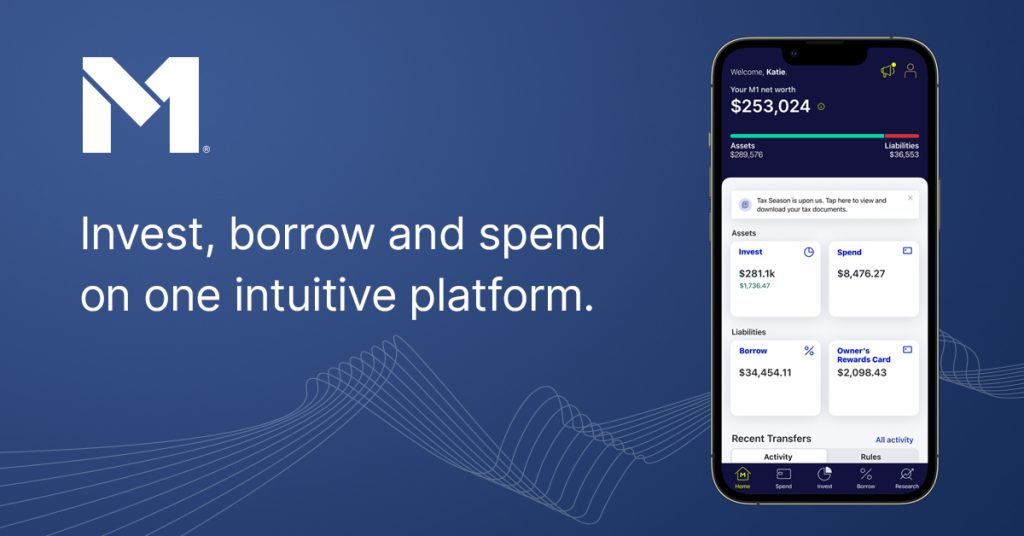The most common question I've been asked recently is this: How do I start investing? So here you go. My guide on how to start investing.
With all this volatility and talk of an upcoming recession, the number one thing people are asking is this: How can I start investing?
Even though the stock market seems to be holding on tightly right now, many people think that it will inevitably drop. And when it does, they want to be ready to swoop in and buy low.
I don't condone market timing. But I will say this — it's always a good time to get started with investing. So, by popular request, here's my take on how to start investing.
Note: If you want knowledge and to just get going, buy my friend David Stein's book, Money for the Rest of Us. You can read my review of the book as well.
How to Start Investing — The Basics
So this is really about making money with stocks. Specifically, how I make money with stocks. If you're looking for the secrets of the universe and how to pick the right stock for you, as well as how to get into all that freaky-deeky stuff around alternative investments just move along.
I'm boring. I'm basic.
It's worked for me thus far, and you're getting how I do the thing. It might not be for you. And that's ok. If my approach isn't your cup of Crio Bru, there are plenty of other folks out there who can help you learn how to start investing their way.
Let's do this.
Start with index funds and ETFs.
The easiest way to start is to invest in a broad-based index mutual fund or exchange-traded fund (ETF). Funds allow you exposure to a collection of investments. This makes it easy to get diversity in one go. You don't have to worry about whether one stock is the “right” choice. Instead, a broad-based index fund or ETF allows you to basically track market performance.
When the market is going gang-busters, that lets you feel like a winner. However, you do have to watch out for when the market in general drops. Because you're investing in vehicles that follow market performance, you'll lose when the market does. The good news is that if you remain calm, there's a good chance you'll recover.
Anyway, index funds and ETFs make up the bulk of my portfolio. Most of mine are stock-based. They include a mix of international stock funds and broad-based U.S. funds. I also have some REITs (for real estate exposure) and some bond index funds.
However, the fact that I use mostly index funds and ETFs makes it easy to construct a portfolio in line with my desired asset allocation, as well as adding instant diversity without the headache of analyzing individual stocks.
Pay attention to asset allocation.
Asset allocation is the idea that your portfolio should be divided up between broad types of investments (asset classes). Research indicates that your asset allocation is more likely to lead to long-term success than what those assets actually are — especially if you use index funds and ETFs.

My asset allocation is based on my goals. Accounts I won't touch for a long period of time are more heavily allocated toward stocks. For example, my current allocations are:
- Retirement: 90/10 stock/bond
- Travel: 50/40/10 stock/bond/REIT
- Long-term emergency: 45/30/15/10 stock/bond/cash/REIT
Toward the end of 2019, I reallocated about 1/3 of my son's 529 so that it was no longer 100% in stocks. Now, 2/3 is in stocks, and the remainder is in “safer” assets that I can draw on when he starts college in 2021. I don't exactly know when any crash or recovery will happen, so I've adopted a modified bucket strategy for the money in my son's 529.
At any rate, the idea is to think about your goals, how soon you might need the money, and how devastating it would be if you had to weather a crash. Choose an asset allocation that works for you, and use index funds and/or ETFs to help you create your portfolio.
Robo-advisors can help.
In the past, I've made heavy use of robo-advisors. They're easy to get started with, offering a low barrier to entry. It's possible to open an account with no minimum at many robo-advisors and then set up regular investments, even transferring as little as $5 at a time.
On top of that, robo-advisors can help you figure out an appropriate asset allocation based on your goals and risk tolerance. Then, they'll do the heavy lifting of deciding what should be in there, usually using ETFs in your portfolio construction.
I recently began moving my money out of Betterment, although I think it's a great tool for the beginning investor. I'm just getting to the point where I need different tools. But if you're just learning how to start investing, a good robo-advisor can be a great choice.
At heart, I'm a super lazy investor. As a result, learning with the help of robo-advisors was great for me. I could start growing my wealth and meeting my goals. Over time, you can move forward, learn new things about investing, and move your money. But if you just want to get started, using index ETFs with the help of a robo-advisor is one of the easiest and fastest ways to get your money in the market.
Use dollar-cost averaging and don't try to time the market.
“Time in the market is more important than timing the market.” — Thing that's said all the time.
As a beginner, using dollar-cost averaging can make a lot of sense. Basically, I have a set amount of money that I contribute to each of my goals each month. I aim to max out my retirement account. My long-term emergency savings account gets the same amount each month, as does my travel fund.
This is money that goes into the account regardless of what's happening in the market. The transfer is automatic, and I don't think about it. I don't pause contributions when the market is up or down. The amount I contribute doesn't change.
Depending on the situation, as I did with my son's 529, I might decide to adjust my asset allocation to reflect a bucket strategy. That way, I know I have access to the money I need for a specific expense when that expense comes due. But, for the most part, while I tweak, I don't make big changes.
Now, I do have a chunk of money that's designed for “bargains.” If an index falls precipitously, I might buy extra shares. Maybe a dividend stock looks like a screaming deal, so I make a purchase. But my core strategy doesn't change.
While you might get fancy later, as a beginner, it's often best to keep it simple. Try some fun new tricks when you've had more experience and done more research. But when you want to start making money with stocks, setting up a regular contribution schedule and sticking to it no matter what is a solid strategy.
What about individual stocks?
If you decide that you want to invest in individual stocks, it's important to research your choices. There are a number of stock market and investment analysis websites that can help you get a handle on different opportunities.
While I don't often invest in individual equities, when I do so, I look for value stocks and concentrate on those that pay dividends. Value stocks are those that are generally trading below what they “should” be on the market and have potential staying power. I like dividend stocks because you receive regular payouts that can be reinvested or eventually provide you with another income stream.
Think about your style and what makes sense for you. Even if you choose individual stocks, there's a good chance you'll be ahead if you avoid frequent trading.
Open a Brokerage Account
In order to invest, you'll need a brokerage account. Most places are pretty simple. The last time I opened an account with a robo-advisor (and I try a lot of them, at least temporarily), it only took me five minutes.
Before you open an account, make sure you know what you're getting.
- Robo-advisor: Easy. Low (or no) minimums. It will help you set up a portfolio using asset allocation. You don't have much control, however. Instead, you'll be stuck with whatever ETFs they get for you, based on your desired asset allocation.
- Online broker: A more traditional broker gives you a little more control. You can still invest in mutual funds and ETFs, though. ETFs are easier because they trade like stocks on the exchange. Many brokers have gotten rid of transaction fees.
Either choice can meet your needs. I started with a robo-advisor because I didn't have much money and I didn't want to have to think about choosing my own investments or rebalancing my own portfolio. But I do have a more traditional online brokerage account for times when I want to do something a little different.
What you need to start investing online.
For the most part, you'll need to provide identifying information and documentation when you open an account. This might include:
- Name
- Address
- Employer (including self-employment)
- Phone number
- Email address
- Drivers license number (or another form of ID)
You also need to provide bank account information, including routing and account number, so that your investment account can be funded.
If you have all of this stuff ready to go, you'll be able to get going much sooner. Some brokers make test deposits, so be aware of that. Additionally, it might take a few business days to move the money from your bank account to your investing account, so you might not have immediate access to the money to start investing.
Most brokers allow you to set up a regular transfer and create an investment plan. Take advantage of this automation so that you don't have to remember to invest each month.
Finally, it might help to use some sort of tool to keep track of your holdings in one place. I use Empower (formerly Personal Capital) to get an overview of all my accounts. However, Ellevest can also help you stay on top of things. Some banks are starting to pull in outside information and even Betterment will allow you to connect outside accounts.
Having these types of analyses can help you get a more holistic view of your portfolio, especially if you have accounts with different brokerages.
How to Start Investing — 8 Places to Open an Account
While you don't want to have your money spread out all over the place, it can make sense to make use of a couple of different brokerages, depending on what you're trying to accomplish. For example, my money is at different brokerages for:
- My HSA
- My main goals (retirement, long-term emergency, travel fund)
- The Boy's 529
- Playtime (individual stocks)
- Short-term splurges
I wouldn't want too many more accounts than that. Otherwise, I run the risk of too much overlap, as well as losing efficiency.
Here are some solid choices to consider when opening your own account.
1. Betterment
Even though I no longer use Betterment, it met my needs for years. Betterment has a checking account and cash reserve account in addition to the ability to set up different accounts for different goals. This is one of my favorite accounts for beginning investors.
2. Schwab
It's possible to open an account with Schwab and begin trading. Plus, Schwab has its own robo product, Intelligent Portfolios. So, you could potentially use Schwab for both types of accounts. There are also banking products, and I know people who have checking accounts and credit cards connected to their investment accounts. There's a lot of versatility there.
Note: My HSA investments are with Schwab through a partnership with Lively HSA, which is in the process of merging with Schwab.
3. Stockpile
For fractional investing, this can be a great choice. You can invest in individual stocks, as well as add ETFs to your portfolio. One thing I like about Stockpile is that you can set up a custodial account for your child and help them start investing.
4. Fidelity
In recent years, Fidelity has added more accounts and features that are friendly to the beginning investor. They have a variety of products and services, including a robo-like product that can help you set up a portfolio. You can trade individual stocks, as well as ETFs, and find mutual funds with low expenses and no transaction fees.
5. Acorns
I use Acorns for my short-term splurges. It's a robo-advisor, so your portfolio is constructed for you, based on your risk tolerance. I like Acorns because I like the idea of round-ups. Each time I use a connected account, it's rounded up to the nearest dollar and the difference is invested. I like it because if I want a weekend getaway or some other treat, I can just see what's in the Acorns account.
6. Stash
This is another robo-advisor that can build a portfolio for you out of pocket change. Make regular transfers, as little as $5 a week, and you can start building. Indeed, Stash offers round-ups, so it's not a bad place to start putting your extra money to good use.
7. Wealthsimple
Along the lines of other robo-advisors like Betterment, you can open an account with a small amount and start building a portfolio. Wealthsimple will create an asset allocation for you and take care of your portfolio over time.
8. M1 Finance
With M1 Finance, you can set up an investment account quickly and easily. However, M1, unlike some of the non-traditional robo-advisors, also allows you to borrow based on your portfolio value. It's a little different. You want to be careful since margin is its own thing, but it's an interesting way to get started, as well as manage other banking products in one account.
Final Thoughts on Making Money with Stocks
As you learn how to start investing, here are a few things to keep in mind:
- Avoid trading too often: You might be tempted to tinker. Don't. It's a good way to be inefficient, especially if you're a beginner.
- Figure out how much you can invest each month: Review your finances and your spending plan. See how much you can invest each month.
- Set up a regular schedule: Take a look at your bills and your usual inflows and outflows. Set up a regular investing schedule and stick with it. Base it around when you usually get paid, as well as when your bills are usually due.
- Increase your contributions over time: While it's nice that you can start investing with pocket change or only put in $5 a week, that's not enough. If you expect to meet your goals, you need to increase your investments over time. Find ways to free up more to invest.
- Branch out with caution: Sure, I occasionally do something different, like VIX, or I pick a few dividend aristocrats. But before you branch out into stock picking or alternative investments, do your research and get solid experience with index funds and ETFs.
My investments have allowed me to meet my lifestyle goals and are an integral part of my short-term and long-term planning. When looking at your own investing plan, keep that in mind. Make sure your own investment strategy — and the assets you use — reflect your own individual needs and goals.




Good advice. Having been an adviser for 30 years and then moving into academia to teach the new breed of advisers I can certainly say that investing is not complicated. I have often said that the large institutions have a very big vested interest in corralling you into their clutches and the best way is to do this is to spread the notion of the great complexities with investing which is best left to the professionals. It’s not complex, it’s certainly not difficult it just requires some dedication and a plan. The info in your post is a great start. Regards Adrian
Love the blog Miranda! I completely agree with the 90/10 stock bond allocation. I use Schwab myself and am in mostly index funds. The most important is just to start as early as you can! Keep up the great work!
Love that you mentioned for beginners to start with index funds & ETFs. They’re simple, yet affective. And in my opinion are a great way for them to learn about the markets.
Appreciate what you do and I like your breakdowns.